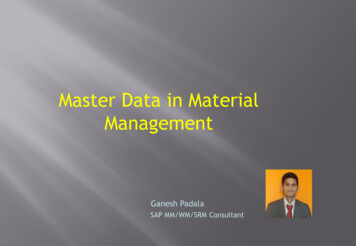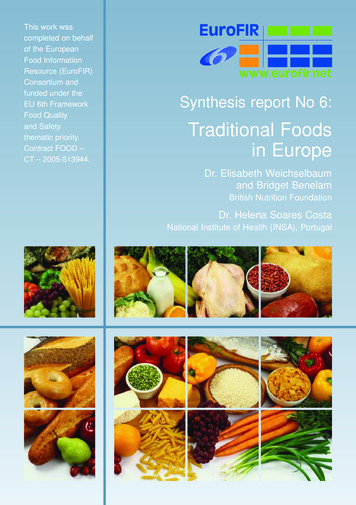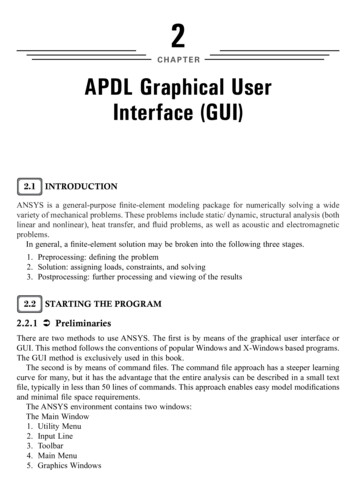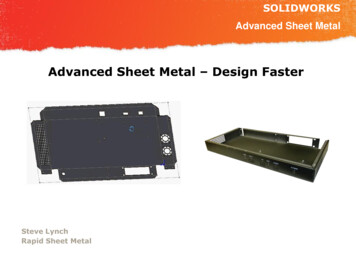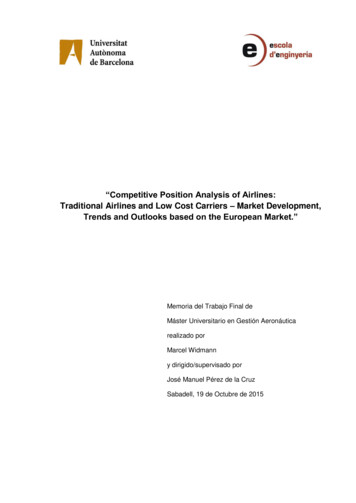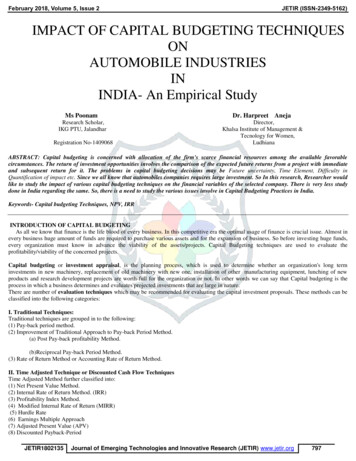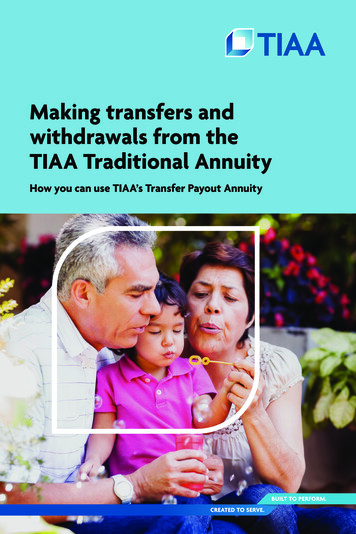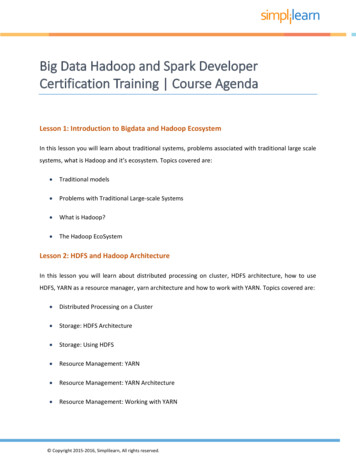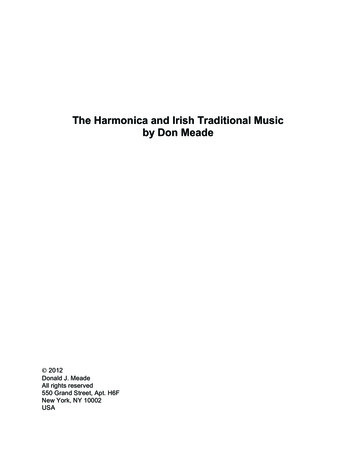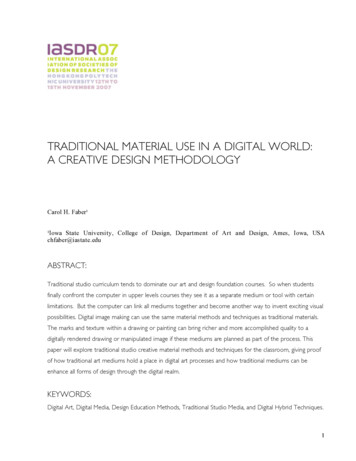
Transcription
TRADITIONAL MATERIAL USE IN A DIGITAL WORLD:A CREATIVE DESIGN METHODOLOGYCarol H. Faber¹¹Iowa State University, College of Design, Department of Art and Design, Ames, Iowa, USAchfaber@iastate.eduABSTRACT:Traditional studio curriculum tends to dominate our art and design foundation courses. So when studentsfinally confront the computer in upper levels courses they see it as a separate medium or tool with certainlimitations. But the computer can link all mediums together and become another way to invent exciting visualpossibilities. Digital image making can use the same material methods and techniques as traditional materials.The marks and texture within a drawing or painting can bring richer and more accomplished quality to adigitally rendered drawing or manipulated image if these mediums are planned as part of the process. Thispaper will explore traditional studio creative material methods and techniques for the classroom, giving proofof how traditional art mediums hold a place in digital art processes and how traditional mediums can beenhance all forms of design through the digital realm.KEYWORDS:Digital Art, Digital Media, Design Education Methods, Traditional Studio Media, and Digital Hybrid Techniques.1
1. INTRODUCTION:The challenge of digital image making in the classroom suggests there is a perception that the computer andits software programs offer all the possibilities for manipulation and effects. “Many artists were first attractedto digital tools because they offered creative opportunities not possible by traditional means.” (Wands, 2006)Yet, students who start working with this technology tend to be software limited and never venture outsidethe constraint of what the software offers as a way to make better marks, textures or unique colorcombinations and effects. When we compare software techniques with traditional studio techniques such asdrawing in charcoal or low relief sculpture of clay, we know that there are limitations we encounter in imagemanipulating in the digital realm. However, the traditional studios techniques such as in painting, drawing,printmaking, and even ceramics, all have a place in digital image making and manipulation. If traditional mediaare introduced within digital technologies, they give way to greater possibilities of effects and surfaces to selectfrom. Traditional techniques can strengthen the impact of an image and create an educational relationshipbetween the digital and traditional techniques of image making.Traditional studio curriculum tends to dominate our art and design foundation courses. So when studentsfinally confront the computer in upper levels courses they see it as a separate medium or tool with certainlimitations. But the computer can link all mediums together and become another way to invent exciting visualpossibilities. Digital image making can use the same material methods and techniques as traditional materials.These traditional methods give new ways to creating digital images and illustrations. The marks and texturewithin a drawing or painting can bring richer and more accomplished quality to a digitally rendered drawing ormanipulated image if these mediums are planned as part of the process.2. A DIFFERENT APPROACH TO THE COMPUTER THROUGH MATERIALSWhen working with the computer as an image-making tool there are certain limitations presented by thepurely physical nature of creating an image. The computer is delicate and not part of the physical world ofimage making. We can’t paint media on it or get it wet and it doesn’t take too much abuse before it stopsworking. So it is limited as a traditional artist’s tool. So how does one get around this problem? In yourcurrent world, especially in the classroom, we approach working with the computer with the physicallimitations of the LCD screen or monitor, keyboard, scanner and digital camera. Computer software programstend to sterilize the mark-making process. The airbrush tool or the brush tool in the Photoshop palette canhardly compare to the “real thing.” Therefore traditional materials and mark-making processes done with2
traditional media are some of the best options to gain back the quality not available through the syntheticmarks of a software program.These limitations set forth a new way of thinking about materials and how we deal with the images we makewithin the digital realm. The problem becomes how do we take images made in a traditional way into thecomputer? Collecting these traditional images becomes one of the crucial steps of working with traditionaltechniques. We tend to primarily use the digital camera to make or gather images. Yet, the digital camera isnot always the best way to great detail and surfaces available in a traditional image. Developing a plan of whatand how to collect images is key to working with the computer.The computer and all it devices, whether they are a flat bed scanner, digital microscope, or three-dimensionalscanner are all a part of the computer and can effect the images we collect and manipulate. Each type ofimage capturing device has the potential to create different effects within the digital palette. These devices arethe first steps in coming to grips with how one creates images using the computer. Which is the best choice,what does each device do differently, and how can experimentation play a decisive role in our understandingof the computer and its image making capabilities? The computer and its devices have become a complextechnological camera with capabilities to manipulate the image it captures in endless configurations.These questions and their challenges form the basis for how can the computer become a rich source forcreating image as any traditional medium. Knowing which methods and techniques help make the computer arich a source for creating images of expression and mark making as any other artist’s or designer’s tool is thekey to success. Creating new ways to explore traditional studio creative material methods and techniques thatintroduce a digital mixed exploration and showing examples of how textures in clay can create a unique effectfor image making, as well as printmaking monotypes, the drawn mark, or the rich pigments of encausticpainting can be an effective way of teaching digital image making.3. THREE CREATIVE METHODS AND TECHNIQUES3.1 TRADITIONAL MEDIA EXPLORATIONWorking with traditional media, such as drawing or painting, gives greater options or ranges when workingwith digital image making. They provide a rich palette of surfaces from which an artist or designer can work.The workflow is to Create many different surfaces on paper or canvas, scan or photograph these marks intodigital files, and then use them for manipulation in software programs. Traditional artist materials, such as3
charcoal, give a surface grain different from that of pencil marks, which tend to create an atmospheric hazeand surface texture. Pencil marks work best linearly, but can also work as a tone. The graphite in pencilstends to give off a sheen when scanning or photographing which can be corrected through software programsuch as Adobe Photoshop. This metallic sheen can also produce beautiful effects in the surface of images. Oilpastels, oil paint, chalk pastels, encaustics, and acrylics have the potential to create dynamic color and surfaceexploration. Wax encaustic marks (Fig. 1) manipulated through layers in Adobe Photoshop show strong marksand color that are indicative of the encaustic medium, which is a material plentiful with saturated color andfluid mark making capabilities.Figure 1: Blue Dance by Carol Faber, 2003. Encaustic Medium Digitally Manipulated in Adobe Photoshop.Many printmaking techniques have been considered part of digital process for sometime especially those thatcombine Inkjet printing with traditional art materials. (Schminke, Krause, and Lhotka, 2004) Many digitalprocedures include printmaking techniques over traditional mediums like a watercolor wash, pastel drawing, oreven photography. However, traditional processes can be reversed by scanning any traditional printmakingtechniques and digitally manipulating these images together. Figure 2 is an example of an original monotypeprinted texture, which has been digitally scanned. Three variations of the monotype print were manipulatedusing Adobe Photoshop are shown in Figure 3. These examples demonstrate how the simplest of images cantake on a new visual identity; yet still retain the original characteristics and quality of marks.4
Figure 2: Monotype Example by Carol Faber, 2004. Direct Scan on original medium.Figure 3: Untitled 2 by Carol Faber, 2005. Digitally manipulated Monotype print in Adobe Photoshop.Three-dimensional low relief surfaces such as wood carving, fabric surfaces, and clay can create effects as richas two-dimensional surfaces in the digital world. Wet clay photographed with a digital camera andmanipulated in layers with other marks created in clay (Fig. 4) shows the potential of what three-dimensionalmedia can offer. The original clay was a gray base, so color transparent layers were added with blendingmodes in layers with Adobe Photoshop to create the color results in this final clay digital surface.Figure 4: Clay Drawing 1 by Carol Faber, 2007. Digitally manipulated in Adobe Photoshop.5
Traditional media exploration becomes a wonderful experimentation process for students in any classroombecause it forces them to think about how art materials might be translated into the digital realm. Noteverything works on the first try or sometimes does not produce the effects that one might expect within asoftware program. Sometimes marks do not have enough contrast or sometimes they have too much coloror contrast. It is a trial and error process. Most traditional materials work best when they are planned aheadand scanned using a flatbed scanner. Some traditional materials such as wet clay are better photographed.Whichever medium is explored, traditional media can significantly expand the capabilities available withindigital imagery.3.2 SURFACE AND TEXTURAL EXPERIMENTATION: FOUND MARKS, OBJECTS, ANDMATERIALSFound marks, objects, and materials are some of the best and most remarkable surfaces to work with usingthe computer. Rather than spending the time making something from a traditional media, such as using apencil to create a hand rendered surface, photographing found textures can give an instant textural effect thatwould take hours to render by hand. Searching for found marks, objects, or materials to create digital drawingeffects is an effective way to experiment with digital texture the same way an artist creates drawn texturesthrough seeing. Combining found marks using a digital camera or scanner with created traditional marks addsnew dimension to the digital process thus enriching the digitally-manipulated marks and images.The best approach for digital image making is to photograph or scan a number of different surfaces from bothnatural and manmade objects to create a number of examples to pull from when working through thecomputer. A surface such as stone, in this case a crystallized center from a geo (Fig. 5), gives the greatestamount of texture through scanning the object. This surface texture and detail is intensified when the image ismanipulated through multiple layering. This immense depth would not be possible without a high-resolutionimage capture device and the close up detail made possible through scanning (Fig. 6).Figure 5: Original Scan of Geo by Carol Faber, 2006.6
Figure 6: Surface 1 by Carol Faber, 2006. Digitally manipulated rock surface.Selecting natural objects with texture and detail (Fig. 7) gives a vast range of colors, interesting shapes, anddistinctive textural relationships that can offer numerous ways to experiment with surface detail, pattern, andthe revelation of something innovative from the familiar. This example of natural objects digitally manipulatedhas strong surface textures and detail of line through the veins of leaves, which mimic linear characteristics ofthe drawn mark. (Fig. 8) Such a visual source becomes a textural reference in the same way that one mightuse still-life objects to observe and draw from, or materials to collect. In the same way as a traditional mediaprocess, this gives another avenue for texture and surface exploration.Figure 7: Original objects used in digital manipulation as a still life in Figure 8 and 9.7
Figure 8: Nature 2 by Carol Faber, 2005. Digitally manipulated natural objects.3.3 DIGITAL EXPERIMENTATION AND MANIPULATION USING TRADITIONALMETHODSWorking with traditional media exploration and the collection of found surface textures provides a newdialogue for digital exploration between the traditional art materials, photographic images, and scannedsurfaces. This creates greater potential for digital experimentation and manipulation using traditional methods.These digital examples become objects, still life imagery, textural renderings, and visual samples to drawendless connections back to the physical relationship of our traditional media beginnings. The drawn marks, inthis example (Fig. 9) provide a connective relationship back to the strong visual surfaces that were capturedand digitally manipulated. Digital colors and surfaces can evoke moods and emotions just as any visual imagecan in the traditional sense.Figure 9: Landscape 1 by Carol Faber, 2006. Mixed media combining drawing digitally manipulated objects8
Expressive marks and colors enhance the digital process. This image (Fig. 10) combines both traditionaldrawing materials with experimental mark making using the encaustics medium, and a natural object, in thiscase horse hair, through the digital layering of transparent colors developed through Adobe Photoshop.Objects and traditional media are successfully integrated and overlapped thus creating a synthesis of surfaces,found objects, textures, and marks. This process is similar to the traditional artistic methods of image making,yet adapts technology within the physical world of making things. The possibilities are endless in combiningtextures over other photographed textures, drawings, paintings, or even sewn fabrics where the threadbecomes a line that also connects to a drawn mark. The process becomes the concept and it can also inspirethe imagery.Figure 10: Remaining Light by Carol Faber, 2003. Combining of Encaustic Media and horsehair digitally.The last set of visual examples were inspired through imagery of the microscopic world. The first image (Fig.11) uses a microscopic cross-section of a water lily leaf as a starting point. This image was in black and whiteand had to be color manipulated and related visually to the rest of the imagery. Scanning a block of ice usingthe back lighting feature on a digital scanner created the surface quality within the piece. This helped tocreate the atmospheric details and soft effects in color. Natural organic leaf forms were collected to relatedback to the microscopic imagery. Twenty-seven layers exist throughout the image, bringing together theconcept and imagery by combining surfaces and photography. The final image uses the same subject of themicroscopic structures of water lilies showing detailed connective starch tissues that resemble starfish-likeshapes invoking the theme of the sea. Seashells and color texture were manipulated to create the oxidativequalities of water rusting over time. Texture plays a critical role in creating the illusion of a watery surfacepooling around the collected objects, thus giving this digital image rich color and texture equal to the surfacesof a painting (Fig. 12).9
Figure 11: Leaves by Carol Faber, 2006. Image created from natural objects and microscopic images.Figure 12: Sea by Carol Faber, 2006. Image created from natural objects and microscopic images.4. CONCLUSIONThe methods addressed could be used in various ways for any course of study in visual art and design. Specificparts from each area could be developed for a traditional art studio course to expand digital techniques andadd a new dimension for learning and exploration. Digitally manipulated imagery can have an impact on manydesign fields. They can be used to provide more interesting value, texture, and color to designed images.These techniques and examples provide proof of how traditional art mediums hold a place in digital artprocesses and how traditional mediums can be enhance all forms of design through the digital realm.REFERENCES:Paul, Christiane. Digital Art. Thames & Hudson Ltd. London, 2003.Schminke, Karin, Dorothy Simpson Krause and Bonny Pierce Lhotka, Digital Art Studio: Techniques for combining InkjetPrinting with Traditional Art Materials. Watson-Guptill Publications, New York, New York, 2004.Wands, Bruce. Art of the Digital Age. Thames & Hudson Inc. New York, New York, 2006, Page 12.10
Digital image making can use the same material methods and techniques as traditional materials. The marks and texture within a drawing or painting can bring richer and more accomplished quality to a digitally rendered drawing or manipulated i
